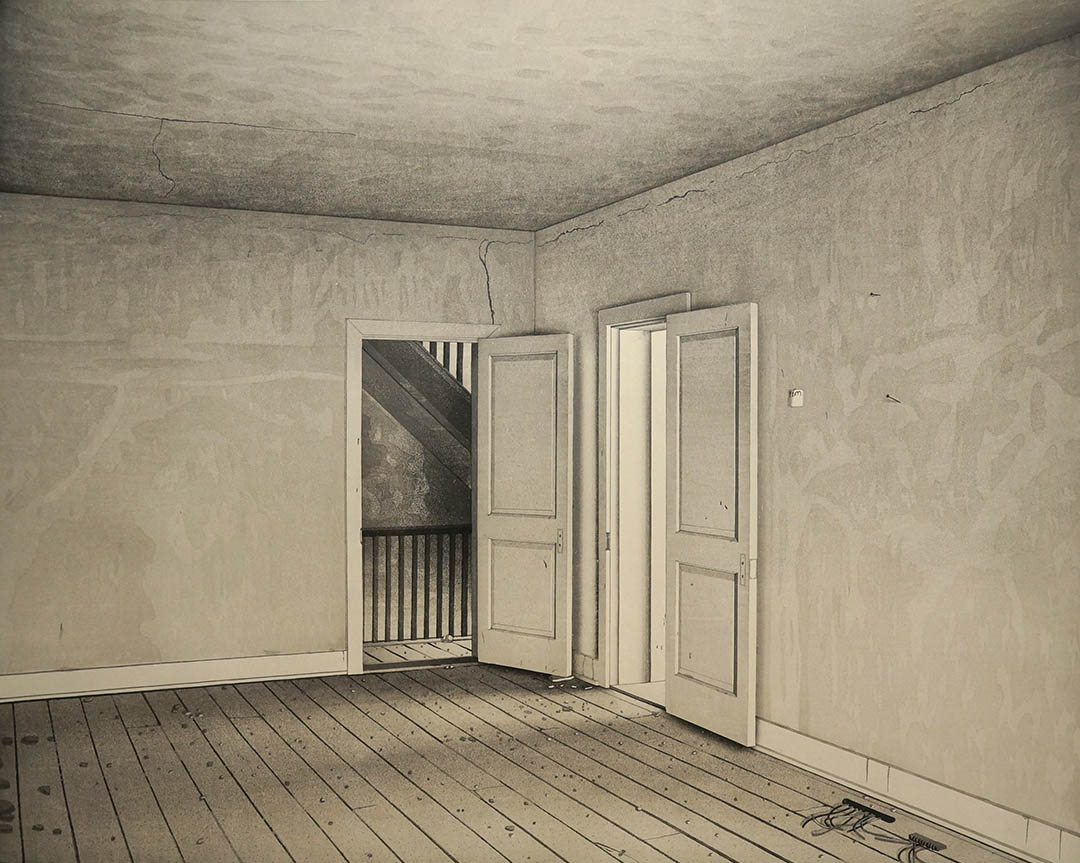Gardar Eide Einarsson’s project for Trykkeriet consists of silkscreens and Japanese woodblock prints based on historical photographs of model housing constructed by the US army at Dugway Proving Ground, 90 miles southwest of Salt Lake City, Utah, an area established during World War II as a test site for chemical and bacteriological weapons.
Here, in the German-Japanese Village, architects including Antonin Raymond – who had previously worked in Japan as Frank Lloyd Wrights asssitant – from 1943 on built exact copies in 1:1 scale of German and Japanese dwellings for the purpose of developing the most effective bombs for the coming firebombing of German and Japanese cities. The buildings, complete with correct Japanese and German interiors were then burnt down and rebuilt at least 27 times.
The structures in this way became a kind of anti-architecture, no longer the “machine for living” described by Le Corbusier but rather the opposite: a machine for dying.
While the silkscreens refer to Andy Warhol’s “Death and Disaster” paintings the woodblocks prints call to mind both a kind of contemplative Northern European interior painting and Tanizaki’s “In Praise of Shadows” a poetry of the everyday that stands in stark contrast to the actual story behind the photographs and a reminder of how external destructive forces lie in wait around the corner from the fragile life individuals try to cultivate.
Gardar Eide Einarsson was born in 1976 in Oslo and currently lives and works in Tokyo. He received his education from the National Academy of Fine Art, Bergen; Staatliche Hochschule für Bildende Kunste – Städelschule – Frankfurt and the Whitney Museum Independent Study Program in New York City.
Institutional solo shows include Kunsthalle Fridericianum, Kassel; Frankfurter Kunstverein; ARoS Aarhus Art Museum; Bergen Kunsthall; Reykjavik Art Museum; Astrup Fearnley Museum of Modern Art; Centre d’Art Contemporain, Geneva; Bonniers Konsthall, Stockholm and Modern Art Museum of Fort Worth;
He has also exhibited in venues including Museum Moderner Kunst Stiftung Ludwig, Vienna; Kunsthalle Wien; Louisiana Museum of Modern Art; Stedelijk Museum Amsterdam; MoMA PS1; The Museum of Contemporary Art, Oslo; MARCO Museo de Arte Contemporaneo, Vigo; Moderna Museet, Stockholm; Serralves Museum of Contemporary Art, Porto; Contemporary Art Museum St. Louis; Museo Tamayo, Mexico City; Kiasma Museum of Contemporary Art, Helsinki; Istanbul Museum of Modern Art; Palais de Tokyo, Paris and Witte de With Center for Contemporary Art and has participated in the Whitney Biennial, the Istanbul Biennial and the Sydney Biennial among others.
Einarsson’s work is represented in a number of public collections including the Museum of Modern Art (MoMA), New York; Los Angeles County Museum of Art (LACMA); Los Angeles Museum of Contemporary Art (LA MoCA); San Francisco Museum of Modern Art (SFMoMA); Berkeley Art Museum; Modern Art Museum of Fort Worth; Museum für Moderne Kunst (MMK) Frankfurt; Moderna Museet, Stockholm; Malmö Art Museum; Astrup Fearnley Museum of Modern Art, Oslo and the Norwegian National Museum of Art, Oslo.
Gardar Eide Einarsson’s work has been covered in Artforum, Frieze, Flash Art, Modern Painters, Art Review, ArtUS, Texte Zur Kunst, The New York Times, The New Yorker, The Wall Street Journal, ViIllage Voice, The Guardian, Interview, L’Officiel, Black Book, Vogue Hommes, Vogue Hommes Nippon, Details, Tokion, Purple Fashion and V Magazine among others.
The Japanese woodcut prints have been produced in collaboration with Mokuhanga master Shoichi Kitamura in Kyoto. This marks the second collaboration between Kitamura woodblock studio and Trykkeriet.
The production and exhibition is supported by the Norwegian Arts Council, the Municipality of Bergen, the Norwegian Embassy in Tokyo, Sasakawa Foundation, Abraham Odfjells stiftelse and Trykkeriet.
